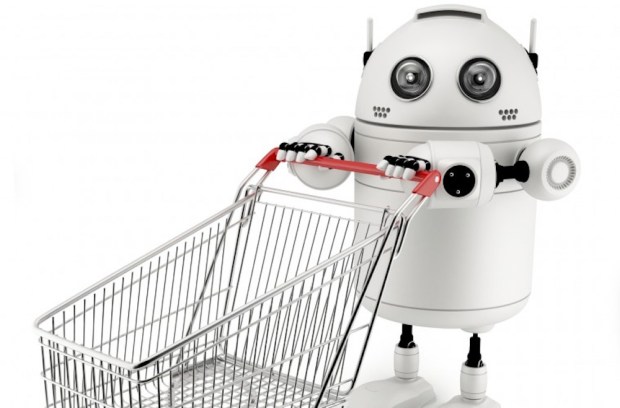The Pros And Cons Of Robots In Retail

Between automated checkout lines, online grocery ordering and meal kit services, it seems like the inexorable tide of progress is determined to wipe out millions of jobs across the retail and grocery sectors. And those are just the new technologies getting the most press.
Financial services firm Cornerstone Capital Group projected that robots will capture between 6 million and 7.5 million jobs over the next 10 years, slashing the 16 million-strong retail workforce by 38 percent. Cashiers will probably be the earliest – but by no means the only – casualties. It has already begun.
In fact, for Walmart, it began a decade ago, when the company had 15 percent more workers per square foot of store than it does today. Self-checkout lanes have given way to self-return touchscreen kiosks (in some locations) and touchscreen info stations where customers can compare like products such as thermostats or internet-connected speakers. Meanwhile, in back rooms, the Cash360 machine is counting bills and coins that used to be tallied by hand.
Whether that’s a good thing or a bad thing depends on who you ask. Eliminating jobs is generally considered bad, but on the other hand, the U.S. in particular has an inordinately high proportion of employees performing routine functions that could be easily automated; maybe it’s doing those employees a favor to free them up to do something more engaging and fulfilling.
If they can find it, that is. The prevailing narrative predicts swaths of low-skilled service-sector workers overwhelming a job market that has fewer options for them than ever before.
But others read the signs differently, seeing just as many (if not more) jobs cropping up in fulfillment and distribution centers as eCommerce continues to grow. In the case of Walmart, there will certainly be new needs – requiring new associates, or reassignment of existing team members – as the company continues to roll out new services like grocery pickup for digital orders.
The coming of the automated era isn’t all doom and gloom. Jobs will be lost, yes, but others will simply change as robots learn to do the rote tasks and empower humans to do what (for now) only humans know how to do: customer interaction and service.
Walmart’s latest patent describes a robot that uses biometrics to read customers’ facial expressions while they wait in line at the point of sale. The AI then analyzes that visual data to determine whether a customer is feeling dissatisfied with his or her experience. If it detects dissatisfaction, it will alert an associate to come to the checkout area and attempt to remedy the situation.
A robot named Tally trawls the aisles of St. Louis grocery stores Schnuck Markets to check for items that need restocking, re-pricing due to error or re-shelving due to messy placement. The real-time information helps associates do their jobs more easily and efficiently without replacing them. Tally, the world’s first autonomous shelf-auditing and analytics robot, answers the insecurities of the 70 percent of retailers who rated themselves “average” or “below average” in terms of inventory management.
Home Depot is testing scanner guns in its self-checkout lines to simplify the process for customers buying bulky items like lumber and save employees from having to man extra cash registers to handle these large items.
“We want to simplify the stores so that we can free up our associates … so they can focus on selling,” Carol Tomé, Home Depot’s chief financial officer, told the Wall Street Journal in light of the news.
In all of these cases, robots aren’t being used to oust people, but to augment them and help them do their jobs better. As long as that attitude prevails in the transition, there should be no need to panic, or to brace ourselves to bow before our robot overlords.
In Other News…
Kroger affiliate Mariano’s, a Chicago-area grocer, is facing a class-action lawsuit led by former employees who said that the company illegally required them to clock hours using fingerprint data via a biometric timekeeping device by Kronos. The issue was not with the time clock system itself, but with Mariano’s failure to obtain written permission from employees to use their biometrics. More than 10,000 employees could be eligible for restitution.
BJ’s Wholesale Club launched its new mobile website to enable easy browsing, research, and of course, savings. The site lets users manage their membership, order ahead at the deli or bakery and access Pick Up & Pay to have their entire grocery order assembled and ready for pickup within two hours.
Supervalu purchased a Joliet, Ill. warehouse vacated by bankrupt grocery cooperative Central Grocers Inc. Supervalu paid $61 million for the nearly 1 million-square-foot space with an eye to improving its distribution capabilities and support Market Centre business expansion.
Coca-Cola has joined forces with Chef’d to add beverages to its meal kits. Original Coke, Dasani sparkling waters and Gold Peak teas will now be included with six of Chef’d’s ready-to-cook dinner kits. Coca-Cola follows in fellow CPG brand Campbell Co.’s footsteps after Campbell became the largest strategic investor in Chef’d earlier this season.
Speaking of Campbell Co., the iconic soup label has announced its withdrawal from the Grocery Manufacturers Assn. by the end of 2017. Campbell was one of the first major CPG companies to require GMO labeling on its own products, and the departure of ways with the GMA furthers its mission to focus on transparency and trust with its customers, CEO Denise Morrison said.
